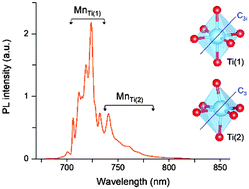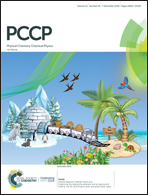Intense deep-red zero phonon line emission of Mn4+ in double perovskite La4Ti3O12
Abstract
Phosphors that emit in the deep-red spectral region are critical for plant cultivation light-emitting diodes. Herein, ultrabroadband deep-red luminescence of Mn4+ in La4Ti3O12 was studied, which showed intense zero phonon line emission. The double-perovskite structural La4Ti3O12 simultaneously contains two Ti4+ sites forming slightly- and highly-distorted TiO6 octahedra, respectively. The influence of octahedral distortion on the Mn4+ emission energy in the two distinct Ti4+ sites was studied both experimentally and theoretically. The spectral measurements indicated that Mn4+ in La4Ti3O12 showed intense zero phonon line emission (ZPL) at deep-red 710–740 nm under excitation of 400 nm charging the O2− → Mn4+ charge transfer transition. The splitting of the ZPL of the Mn4+ 2Eg → 4A2g transition as well as the intensity of ZPL relative to the vibronic phonon sideband emissions were found to be greatly influenced by the degree of octahedral distortion. The crystal-field strength and Racah parameters of Mn4+ in each Ti4+ site were also estimated. The Mn4+ 2Eg → 4A2g luminescence exhibited severe thermal quenching, which was explained by the low-lying 4T2g level and charge-transfer state.



 Please wait while we load your content...
Please wait while we load your content...
